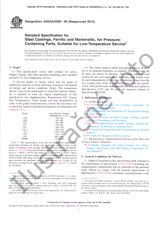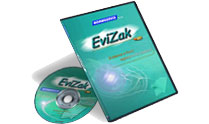Potrebujeme váš súhlas na využitie jednotlivých dát, aby sa vám okrem iného mohli ukazovať informácie týkajúce sa vašich záujmov. Súhlas udelíte kliknutím na tlačidlo „OK“.
ASTM D7380-15
Standard Test Method for Soil Compaction Determination at Shallow Depths Using 5-lb (2.3 kg) Dynamic Cone Penetrometer
Automaticky preložený názov:
Štandardná skúšobná metóda pre stanovenie zhutnenie pôdy v malých hĺbkach s použitím 5 libier ( 2,3 kg ) , Dynamic Cone penetrometricky
NORMA vydaná dňa 1.11.2015
Informácie o norme:
Označenie normy: ASTM D7380-15
Poznámka: NEPLATNÁ
Dátum vydania normy: 1.11.2015
Kód tovaru: NS-620501
Počet strán: 9
Približná hmotnosť: 27 g (0.06 libier)
Krajina: Americká technická norma
Kategória: Technické normy ASTM
Kategórie - podobné normy:
Fyzikální vlastnosti půd
Zemní práce. Hloubicí práce. Budování základů. Podzemní práce
Anotácia textu normy ASTM D7380-15 :
Keywords:
compaction test, cone, cone penetrometer, construction control, dynamic cone penetration test, 5-lb DCP, soil compaction, percent compaction, soil density, water content,, ICS Number Code 13.080.20 (Physical properties of soil),93.020 (Earth works. Excavations. Foundation construction. Underground works)
Doplňujúce informácie
| Significance and Use | ||||||||||||||||||||||
|
5.1 The test method is used to assess the compaction effort of compacted materials. The number of drops required to drive the cone a distance of 3.25 in. (83 mm) is used as a criterion to determine the pass or fail in terms of soil percent compaction. 5.2 The device does not measure soil compaction directly and requires determining the correlation between the number of drops and percent compaction in similar soil of known percent compaction and water content. 5.3 The number of drops is dependent on the soil water content. Calibration of the device should be performed at a water content equal to the water content expected in the field. 5.4 There are other DCPs with different dimensions, hammer weights, cone sizes, and cone geometries. Different test methods exist for these devices (such as D6951) and the correlations of the 5-lb DCP with soil percent compaction are unique to this device. 5.5 The 5-lb DCP is a simple device, capable of being handled and operated by a single operator in field conditions. It is typically used as Quality Control (QC) of layer-by-layer compaction by construction crew in roadway pavement, backfill compaction in confined cuts and trenches, and utility pavement restoration work. Note 1: The quality of results produced by this test method is
dependent on the competence of the personnel performing it and the
suitability of the equipment and facilities used. Agencies that
meet the criteria of Practice D3740 are generally considered capable of
competent and objective testing/sampling/inspection/etc. Users of
this standard are cautioned that compliance with Practice
D3740 does not in itself
assure reliable results. Reliable results depend on many factors;
Practice D3740 provides a
means of evaluating some of these factors.
|
||||||||||||||||||||||
| 1. Scope | ||||||||||||||||||||||
|
1.1 This test method covers the procedure for the determination of the number of drops required for a dynamic cone penetrometer with a 5-lb (2.3-kg) drop hammer falling 20 in. (508 mm) to penetrate a certain depth in compacted backfill. 1.2 The device is used in the compaction verification of fine- and coarse-grained soils, granular materials, and weak stabilized or modified material used in subgrade, base layers, and backfill compaction in confined cuts and trenches at shallow depth. 1.3 The test method is not applicable to highly stabilized and cemented materials or granular materials containing a large percentage of aggregates greater than 1.5 in. (37 mm). 1.4 The method is dependent upon knowing the field water content and the user having performed calibration tests to determine cone penetration resistance of various compaction levels and water contents. 1.5 The values stated in inch-pound units are to be regarded as standard. The values given in parentheses are mathematical conversions to SI units that are provided for information only and are not considered standard. 1.6 It is common practice in the engineering profession to concurrently use pounds to represent both a unit of mass (lbm) and a force (lbf). This implicitly combines two separate systems of units; that is, the absolute system and the gravitational system. This standard has been written using the gravitational system of units when dealing with the inch-pound system. In this system, the pound (lbf) represents a unit of force (weight). However, the use of balances or scales recording pounds of mass (lbm) or the reading of density in lbm/ft3 shall not be regarded as a nonconformance with this standard. 1.7 All observed and calculated values shall conform to the guidelines for significant digits and rounding established in Practice D6026. 1.8 This standard does not purport to address all of the safety concerns, if any, associated with its use. It is the responsibility of the user of this standard to establish appropriate safety and health practices and determine the applicability of regulatory limitations prior to use. |
||||||||||||||||||||||
| 2. Referenced Documents | ||||||||||||||||||||||
|
Odporúčame:
EviZak - všetky zákony vrátane ich evidencie na jednom mieste
Poskytovanie aktuálnych informácií o legislatívnych predpisoch vyhlásených v Zbierke zákonov od roku 1945.
Aktualizácia 2x v mesiaci !
Chcete vedieť viac informácii ? Pozrite sa na túto stránku.




 Cookies
Cookies
